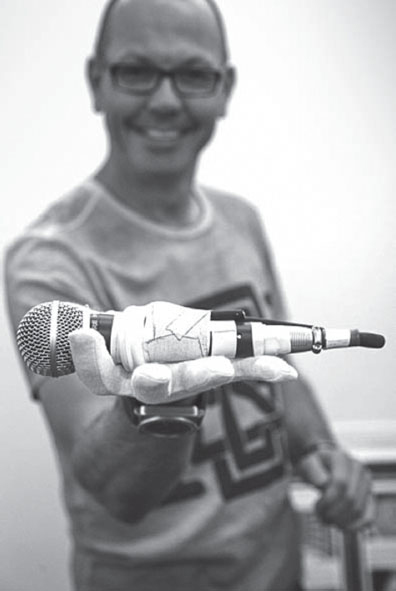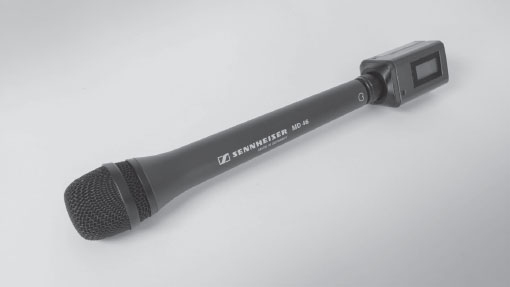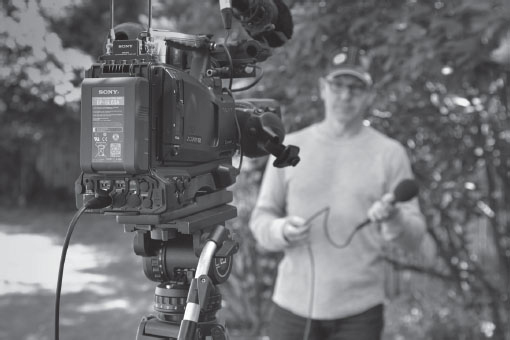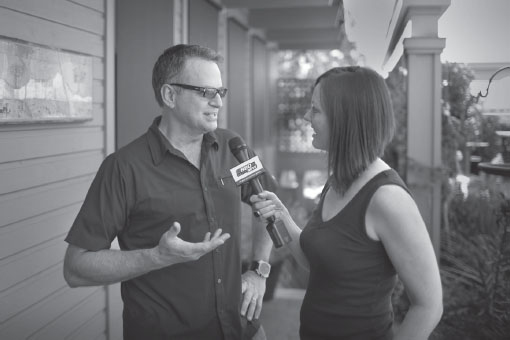The dynamic handheld mic, you’ve seen them thousands of times but might not know it. Rock stars screaming into them, flinging them around by the cord, smashed, and bashed. The dynamic microphone has been around for a long time and many, like the Shure SM58, are pretty much indestructible!

One of Roger Daltrey’s microphones! Yes, my friends, I got to touch it!
The dynamic microphones we use for TV are basically the same mic, except they’re shaped differently to be more visually appealing. TV handheld microphones have longer bodies so talent can keep their hand further out of the shot. The long body also enables talent to reach further to put the mic in position when conducting a “streeter”-type interview.

Sennheiser MD46 handheld mic with a wireless transmitter
DYNAMIC MICS
Dynamic mics do not require power from a battery or +48V phantom from a camera to work. They use the energy of the voice to move the diaphragm of the mic to create the signal. Because of this, they need to be very close to the sound source (talent’s mouth) to pick up any usable sound. They are fantastic for loud environments like sporting events, concerts or any location where the ambience is extremely loud. Headset mics (headphones with a mic attached), like the ones you see the commentator wearing at a football game, use dynamic mics.
Handheld mics can be hardwired to your camera with an XLR cable or used with a wireless system. The plastic cube you see close to the head of the mic is called a flasher. They don’t affect the sound in any way: they’re just used to identify the network, channel, show, etc.

Dynamic handheld mic connected to the camera with an XLR cable
Handheld mics need to point directly at the sound source (the mouth) to work properly and the louder the location, the closer the mic needs to be. Dynamic handhelds are designed to handle high SPLs (sound pressure levels), so the mic needs to be close to the mouth for them to work properly. If talent is not used to interviewing with a handheld mic, you’ll need to give them a quick lesson. If they’re not getting the mic in place quick enough or start using it as a pointer, your sound is going to suffer. Make sure you’re wearing headphones when shooting interviews with handheld microphones to make sure the dialogue is intelligible.

Scot being interviewed, note the position of the handheld
SETTING THE INPUT LEVELS WHEN HARDWIRED
When recording with a dynamic handheld mic connected directly to your camera with an XLR cable, you’re going to have to pay close attention to your meters. Depending on how loud the location is and how loud talent speaks, even yells, you’re going to adjust the input dial on the camera to have the meters indicating between −6dB and −12db. This is the one time you could have the input dial cranked higher than 8 or lower than 3, it all depends on the amount of volume (signal) entering the dynamic handheld microphone.
SETTING THE INPUT LEVELS WHEN USING A WIRELESS SYSTEM
When using a dynamic mic with a wireless system, you’ll set the input level at the transmitter. You’ll calibrate the transmitter to receive the signal from a dynamic microphone the same as you would a lavalier. So have talent speak at performance volume and adjust the transmitter’s input level—don’t be surprised if the input level into the transmitter is either really high or very low; it all depends on the volume of the location and the volume talent speaks.

// Watch Class 16—“Handheld Mics” of the Camera Audio Simplified online course //
